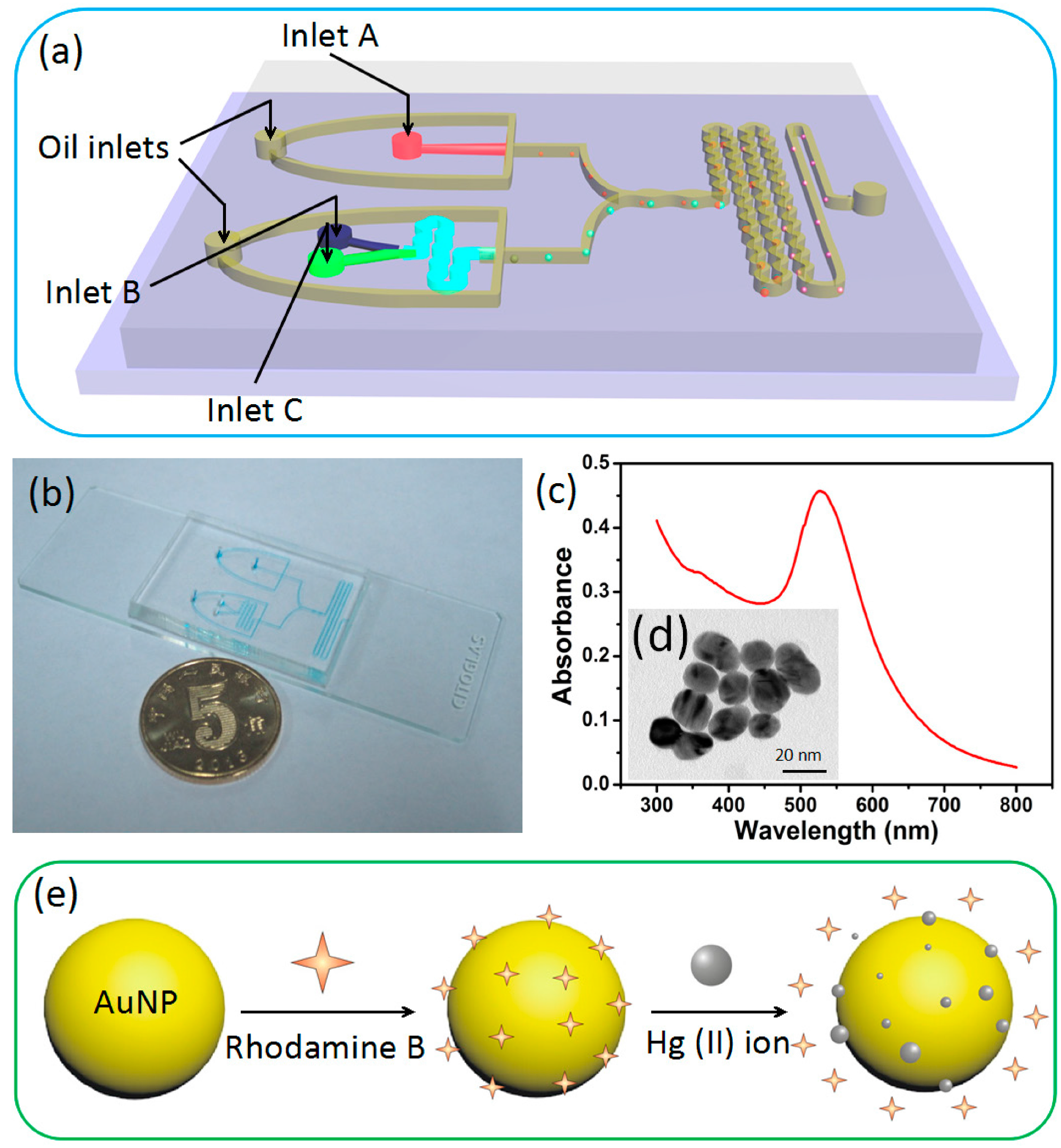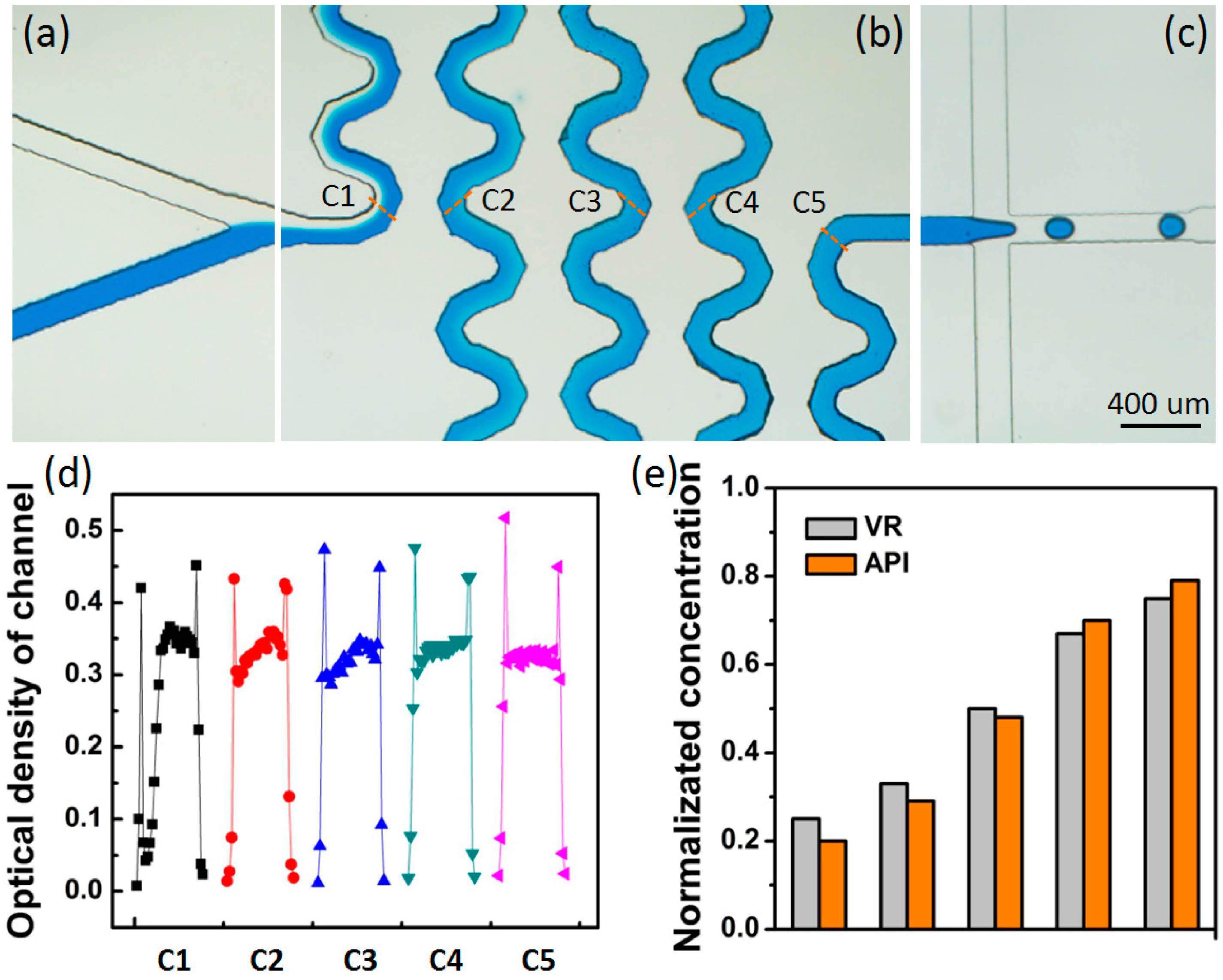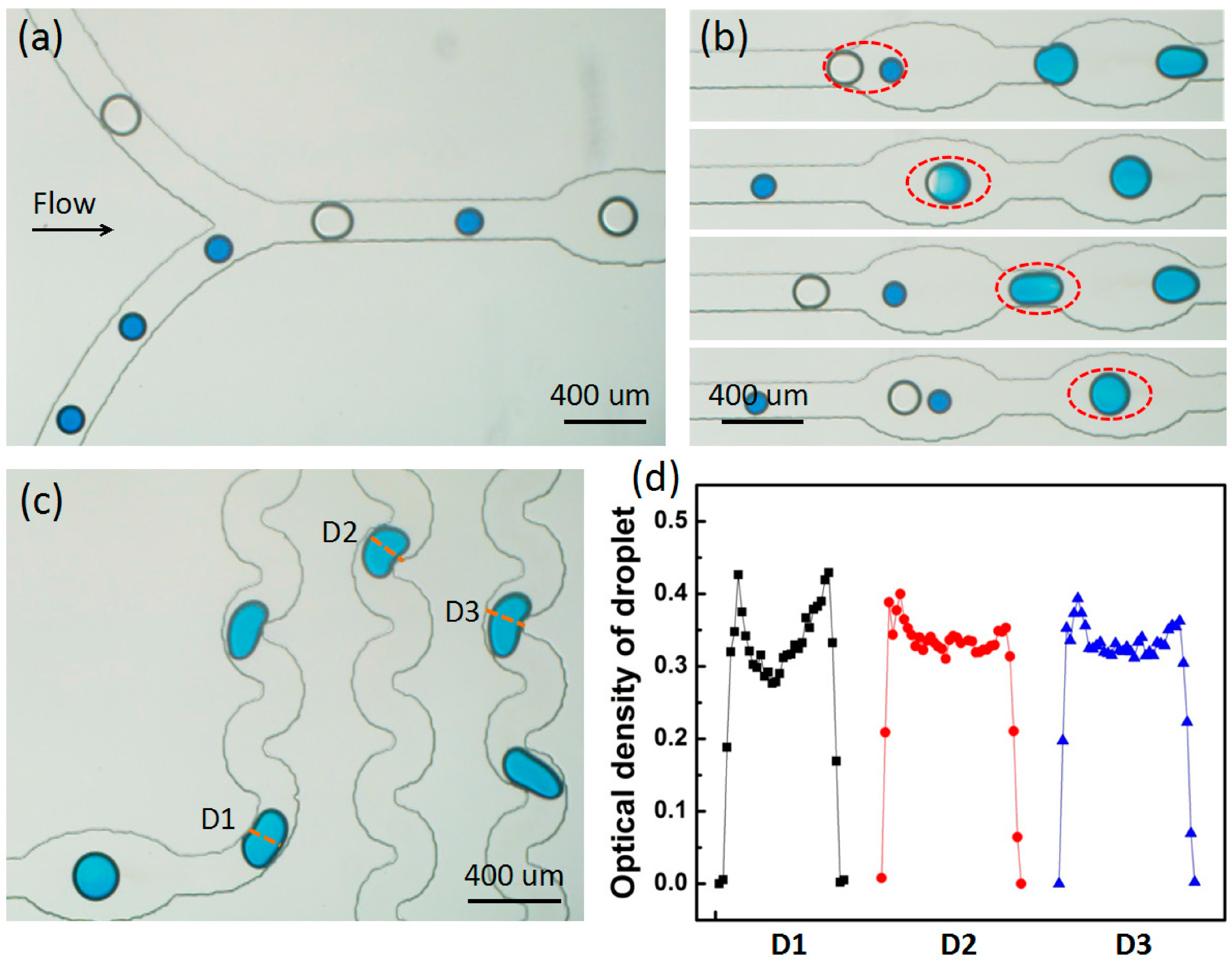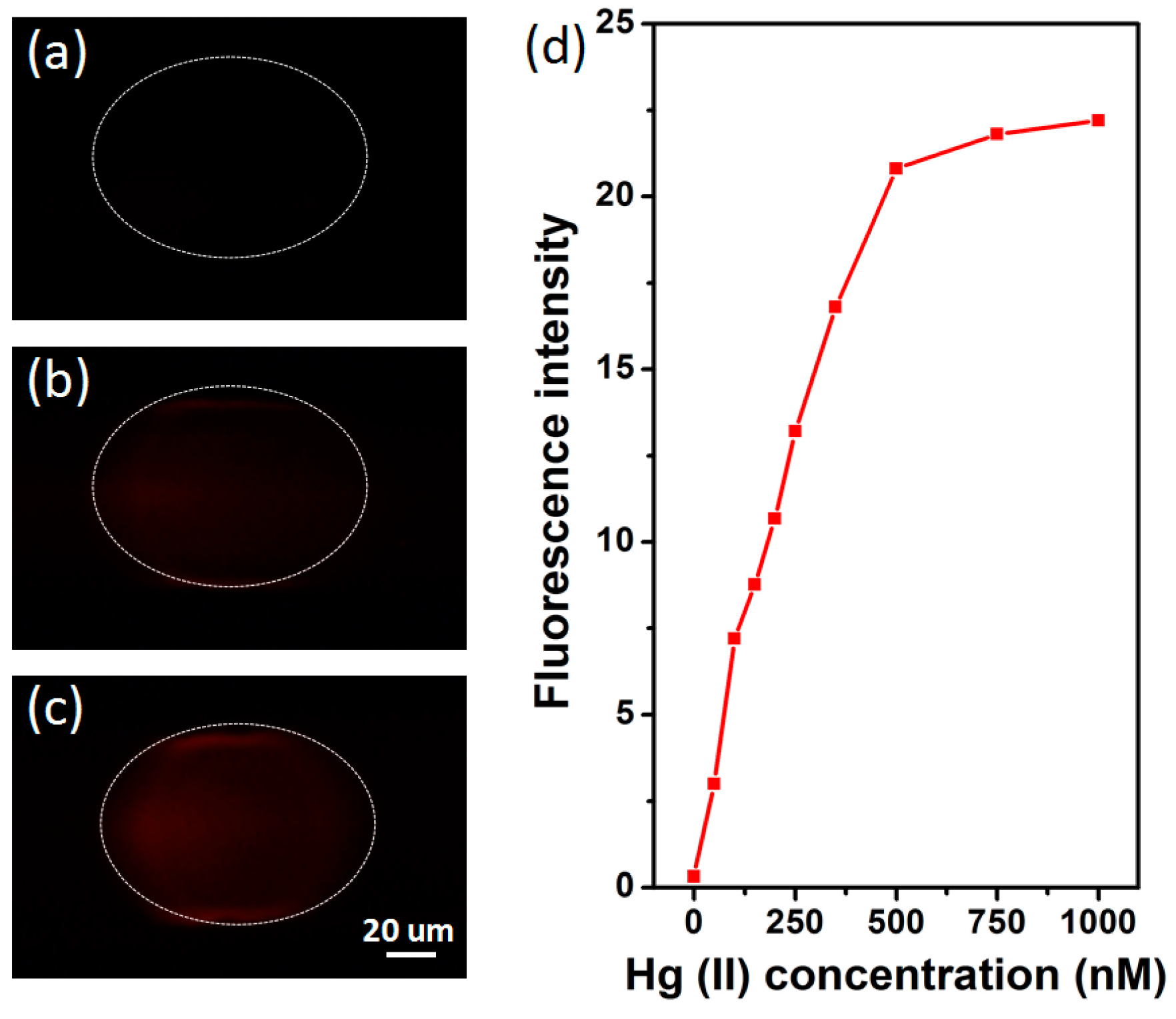A Concentration-Controllable Microfluidic Droplet Mixer for Mercury Ion Detection
Abstract
:1. Introduction
2. Material and Methods
2.1. Microfluidic Device Design and Fabrication
2.2. On-Chip Operation
2.3. Hg(II) Ion Detection
2.3.1. Preparation of Gold Nanoparticles
2.3.2. Principle of Hg(II) Ion Detection

3. Results and Discussion
3.1. Concentration Control of Aqueous Solution

3.2. Droplet Generation and Fusion


3.3. Hg(II) Ion Detection

4. Conclusions
Acknowledgements
Author Contributions
Conflicts of Interest
References
- Morel, F.; Kraepiel, A.; Amyot, M. The chemical cycle and bioaccumulation of mercury. Annu. Rev. Ecol. Syst. 1998, 29, 543–566. [Google Scholar] [CrossRef]
- Clarkson, T.W.; Magos, L.; Myers, G.J. The toxicology of mercury-current exposures and clinical manifestations. New Engl. J. Med. 2003, 349, 1731–1737. [Google Scholar] [CrossRef] [PubMed]
- Kopysc, E.; Pyrzynska, K.; Garbos, S.; Bulska, E. Determination of Mercury by cold-vapor atomic absorption spectrometry with preconcentration on a gold-trap. Anal. Sci. 2000, 16, 1309–1312. [Google Scholar] [CrossRef]
- Karunasagar, D.; Arunachalam, J.; Gangadharan, S. Development of a “collect and punch” cold vapour inductively coupled plasma mass spectrometric method for the direct determination of mercury at nanograms per litre levels. J. Anal. At. Spectrom. 1998, 13, 679–682. [Google Scholar] [CrossRef]
- Yu, L.-P.; Yan, X.-P. Flow injection on-line sorption preconcentration coupled with cold vapor atomic fluorescence spectrometry and on-line oxidative elution for the determination of trace mercury in water samples. At. Spectrosc. 2004, 25, 145–153. [Google Scholar]
- Yin, X.; Xu, Q.; Xu, X. Speciation analysis of mercury I. Separation and determination of methylmercury, ethylmercury, phenylmercury and mercury (II) by liquid chromatography after chloroform extraction. Chin. J. Anal. Chem. 1995, 10, 1168–1171. [Google Scholar]
- Shen, J.; Li, Y.; Gu, H.; Xia, F.; Zuo, X. Recent development of sandwich assay based on the nanobiotechnologies for proteins, nucleic acids, small molecules, and ions. Chem. Rev. 2014, 114, 7631–7677. [Google Scholar] [CrossRef] [PubMed]
- Chen, J.; Zheng, A.; Chen, A.; Gao, Y.; He, C.; Kai, X.; Wu, G.; Chen, Y. A functionalized gold nanoparticles and Rhodamine 6G based fluorescent sensor for high sensitive and selective detection of mercury (II) in environmental water samples. Anal. Chim. Acta 2007, 599, 134–142. [Google Scholar] [CrossRef] [PubMed]
- Guo, C.; Irudayaraj, J. Fluorescent Ag clusters via a protein-directed approach as a Hg(II) ion sensor. Anal. Chem. 2011, 83, 2883–2889. [Google Scholar] [CrossRef] [PubMed]
- Duan, J.; Jiang, X.; Ni, S.; Yang, M.; Zhan, J. Facile synthesis of N-acetyl-l-cysteine capped ZnS quantum dots as an eco-friendly fluorescence sensor for Hg2+. Talanta 2011, 85, 1738–1743. [Google Scholar] [CrossRef] [PubMed]
- Chen, K.; Lu, G.; Chang, J.; Mao, S.; Yu, K.; Cui, S.; Chen, J. Hg(II) ion detection using thermally reduced graphene oxide decorated with functionalized gold nanoparticles. Anal. Chem. 2012, 84, 4057–4062. [Google Scholar] [CrossRef] [PubMed]
- Huang, C.C.; Yang, Z.; Lee, K.H.; Chang, H.T. Synthesis of highly fluorescent gold nanoparticles for sensing mercury (II). Angew. Chem. 2007, 119, 6948–6952. [Google Scholar] [CrossRef]
- Ye, B.C.; Yin, B.C. Highly sensitive detection of mercury (II) ions by fluorescence polarization enhanced by gold nanoparticles. Angew. Chem. Int. Ed. 2008, 47, 8386–8389. [Google Scholar] [CrossRef] [PubMed]
- Rex, M.; Hernandez, F.E.; Campiglia, A.D. Pushing the limits of mercury sensors with gold nanorods. Ana. Chem. 2006, 78, 445–451. [Google Scholar] [CrossRef] [PubMed]
- Whitesides, G.M. The origins and the future of microfluidics. Nature 2006, 442, 368–373. [Google Scholar] [CrossRef] [PubMed]
- Demello, A.J. Control and detection of chemical reactions in microfluidic systems. Nature 2006, 442, 394–402. [Google Scholar] [CrossRef] [PubMed]
- Lafleur, J.P.; Senkbeil, S.; Jensen, T.G.; Kutter, J.P. Gold nanoparticle-based optical microfluidic sensors for analysis of environmental pollutants. Lab Chip 2012, 12, 4651–4656. [Google Scholar] [CrossRef] [PubMed]
- Sara Gómez-de, P.; Lopes, D.; Miltsov, S.; Izquierdo, D.; Alonso-Chamarro, J.; Puyol, M. Optical microfluidic system based on ionophore modified gold nanoparticles for the continuous monitoring of mercuric ion. Sens. Actuators B Chem. 2014, 194, 19–26. [Google Scholar]
- Brouzes, E.; Medkova, M.; Savenelli, N.; Marran, D.; Twardowski, M.; Hutchison, J.B.; Rothberg, J.M.; Link, D.R.; Perrimon, N.; Samuels, M.L. Droplet microfluidic technology for single-cell high-throughput screening. Proc. Nat. Acad. Sci. 2009, 106, 14195–14200. [Google Scholar] [CrossRef] [PubMed]
- Guo, F.; Ji, X.-H.; Liu, K.; He, R.-X.; Zhao, L.-B.; Guo, Z.-X.; Liu, W.; Guo, S.-S.; Zhao, X.-Z. Droplet electric separator microfluidic device for cell sorting. Appl. Phys. Lett. 2010, 96, 193701. [Google Scholar] [CrossRef]
- Rao, L.; Cai, B.; Wang, J.; Meng, Q.; Ma, C.; He, Z.; Xu, J.; Huang, Q.; Li, S.; Cen, Y.; et al. A microfluidic electrostatic separator based on pre-charged droplets. Sen. Actuators B Chem. 2015, 210, 328–335. [Google Scholar] [CrossRef]
- Hsu, K.-C.; Lee, C.-F.; Tseng, W.-C.; Chao, Y.-Y.; Huang, Y.-L. Selective and eco-friendly method for determination of mercury (II) ions in aqueous samples using an on-line AuNPs–PDMS composite microfluidic device/ICP-MS system. Talanta 2014, 128, 408–413. [Google Scholar] [CrossRef] [PubMed]
- Xia, Y.; Whitesides, G.M. Soft Lithography. Angew. Chem. Int. Ed. 1998, 37, 550–575. [Google Scholar] [CrossRef]
- Cai, B.; Guo, F.; Zhao, L.; He, R.; Chen, B.; He, Z.; Yu, X.; Guo, S.; Xiong, B.; Liu, W.; Zhao, X.-Z. Disk-like hydrogel bead-based immunofluorescence staining toward identification and observation of circulating tumor cells. Microfluid. Nanofluid. 2014, 16, 29–37. [Google Scholar] [CrossRef]
- Liu, K.; Ding, H.; Chen, Y.; Zhao, X.-Z. Droplet-based synthetic method using microflow focusing and droplet fusion. Microfluid. Nanofluid. 2007, 3, 239–243. [Google Scholar] [CrossRef]
- Rao, L.; Cai, B.; Yu, X.-L.; Guo, S.-S.; Liu, W.; Zhao, X.-Z. One-step fabrication of 3D silver paste electrodes into microfluidic devices for enhanced droplet-based cell sorting. AIP Adv. 2015, 5, 057134. [Google Scholar] [CrossRef]
- Huang, C.-C.; Chang, H.-T. Selective gold-nanoparticle-based “turn-on” fluorescent sensors for detection of mercury (II) in aqueous solution. Anal. Chem. 2006, 78, 8332–8338. [Google Scholar] [CrossRef] [PubMed]
- Guo, Z.-X.; Zeng, Q.; Zhang, M.; Hong, L.-Y.; Zhao, Y.-F.; Liu, W.; Guo, S.-S.; Zhao, X.-Z. Valve-based microfluidic droplet micromixer and mercury (II) ion detection. Sens. Actuators A Phy. 2011, 172, 546–551. [Google Scholar] [CrossRef]
© 2015 by the authors; licensee MDPI, Basel, Switzerland. This article is an open access article distributed under the terms and conditions of the Creative Commons Attribution license (http://creativecommons.org/licenses/by/4.0/).
Share and Cite
Meng, Q.-F.; Rao, L.; Cai, B.; You, S.-J.; Guo, S.-S.; Liu, W.; Zhao, X.-Z. A Concentration-Controllable Microfluidic Droplet Mixer for Mercury Ion Detection. Micromachines 2015, 6, 915-925. https://doi.org/10.3390/mi6070915
Meng Q-F, Rao L, Cai B, You S-J, Guo S-S, Liu W, Zhao X-Z. A Concentration-Controllable Microfluidic Droplet Mixer for Mercury Ion Detection. Micromachines. 2015; 6(7):915-925. https://doi.org/10.3390/mi6070915
Chicago/Turabian StyleMeng, Qian-Fang, Lang Rao, Bo Cai, Su-Jian You, Shi-Shang Guo, Wei Liu, and Xing-Zhong Zhao. 2015. "A Concentration-Controllable Microfluidic Droplet Mixer for Mercury Ion Detection" Micromachines 6, no. 7: 915-925. https://doi.org/10.3390/mi6070915
APA StyleMeng, Q.-F., Rao, L., Cai, B., You, S.-J., Guo, S.-S., Liu, W., & Zhao, X.-Z. (2015). A Concentration-Controllable Microfluidic Droplet Mixer for Mercury Ion Detection. Micromachines, 6(7), 915-925. https://doi.org/10.3390/mi6070915





